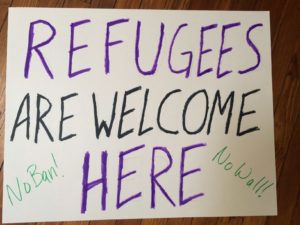Airports and cities large and small erupted into chaos this weekend as Donald Trump’s executive order temporarily banning Muslims from Iraq, Syria, Sudan, Iran, Somalia, Libya and Yemen from entering the US took effect.
People with valid entry visas and legal permanent resident status (“green card” holders) were detained at airports across the country. Immigration attorneys flocked to terminals to provide pro bono legal assistance to those detained, and citizens took to the airport terminals and the streets to speak out against this.
This is a crisis for the association industry, as clearly illustrated by the many immediate responses, particularly from STEM associations, who are likely to be some of the first associations profoundly impacted by this order.
The @AssocVoices Twitter account has been doing an excellent job of collecting and disseminating responses from diverse associations like:
- American Association of Universities
- Internet Association
- Association for Computing Machinery
- American Chemical Society
Of course, the American Immigration Lawyers Association has been on the forefront of this issue.
Associations need to think about and plan responses for questions that affect us like:
- Will international attendees be able to come to our US-based conferences?
- If an international attendee is detained trying to come to your event, what will your association’s response be?
- Will US-based members who are “green card” holders or here on visas be able to attend conferences we hold outside the US (remember, if they leave they may not be allowed to return)?
- Will US-based staff who are “green card” holders or here on visas be able to travel internationally for work (remember, if they leave they may not be allowed to return)?
- Will US-based staff who are “green card” holders or here on visas be able to travel to their home countries to visit family or friends (remember, if they leave they may not be allowed to return)?
- If members or staff are prevented from re-entering the US after leaving for association-related business, what will your association’s response be?
Edited to add: Ann Feeney, CAE added the following excellent questions during a discussion of this topic on ASAE’s Collaborate community (login required):
Situational awareness
- What sources are you using for ongoing information? Are there any outside the mainstream news (e.g. law professors, specialty organizations) that you’d strongly recommend?
- If you’re planning to get professional counsel on the topic, from whom?
Expansion of the list of countries
- Are you also creating contingency plans for the inclusion of other countries on the list? If so, which? (Some of the countries that I’ve seen mentioned in the context of expansion are Egypt, Indonesia, the Chechen-majority parts of Russia, Saudi Arabia, Turkey, eastern Turkey, and the UAE. Alphabetical order, not frequency of mention.)
Conferences
- Are you adjusting conference attendance projections? If so, is this solely for the countries on the list or are you assuming that other international attendees may be deterred from traveling?
- Are you talking to conference venues or service providers about options for remote attendance? If so, how would you handle pricing and subsequent revenue forecasts and modeling?
Staff
- The ethics of diversity and inclusion, as well as the law, call for hiring regardless of national origin, but is the ability to travel freely to any country a key job requirement for any positions? If so, what are the legal and ethical ramifications of taking nation of origin into consideration for hiring?
Recruitment and retention
- What are the ramifications for board recruitment and retention? For other volunteers?
Communications
- How are you communicating to stakeholders, given the rate of change about these executive orders, their interpretation, and the legal challenges? Interjecting a personal note, I’ve personally often found that a tremendous challenge during any times of very rapid change–how do you balance keeping people informed and not over-informing, and providing information in a timely fashion and having to retract earlier information that’s no longer applicable.
What is your association planning by way of response? What is your crisis plan for this?
Edited to add: ASAE has signed onto a letter, prepared jointly by a variety of science organizations, directly opposing the ban.
As of February 9, 2017, the Ninth Circuit Court of Appeals has ruled against the Trump administration (PDF), leaving the stay against the executive order in place.
